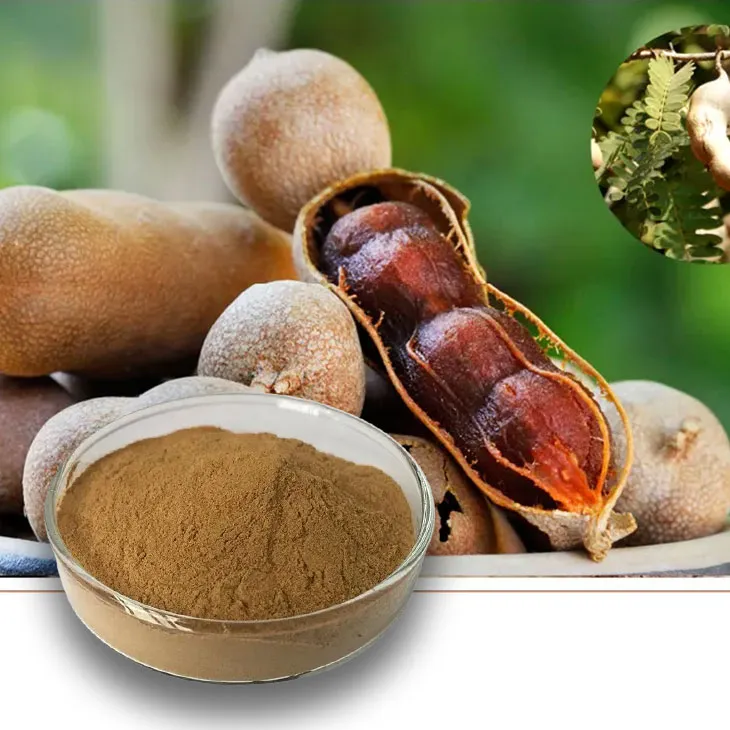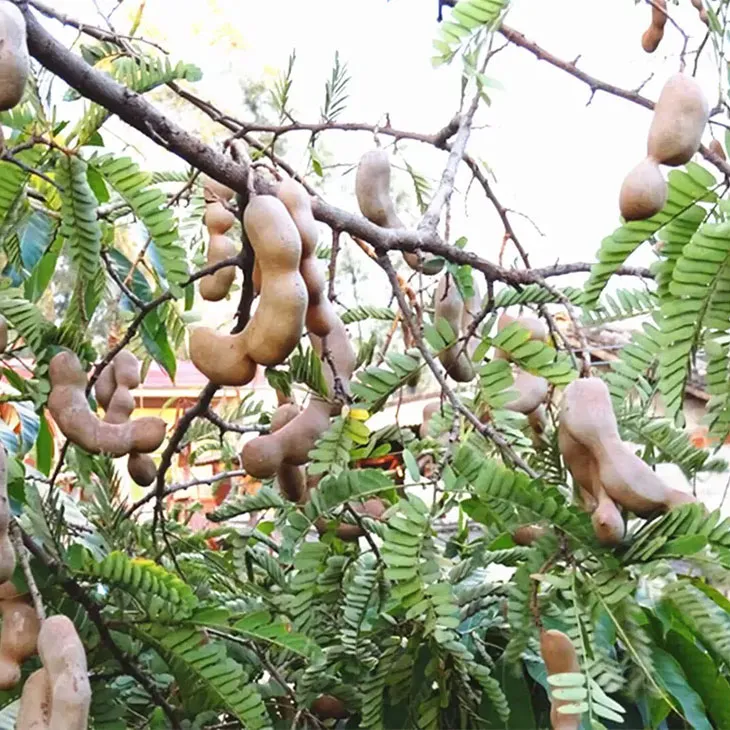- 0086-571-85302990
- sales@greenskybio.com
Organic Tamarind Extract Powder Supplier
2024-11-29

Introduction
Organic Tamarind extract powder has a wide array of applications, and the suppliers are at the heart of making it accessible to the market. These suppliers play a crucial role in ensuring that the product meets the high standards demanded by various industries.

The Sourcing Process
Relationship with Growers
The process of supplying organic Tamarind extract powder involves several steps. First, the suppliers need to establish strong relationships with organic tamarind growers. This is not only essential for a consistent supply of high - quality raw materials but also for promoting sustainable farming practices. Suppliers often work closely with growers to ensure that they adhere to organic farming standards. By having a reliable network of growers, suppliers can better control the quality of the tamarinds they receive.Knowledge of Tamarind Varieties
They also need to be well - versed in the different varieties of tamarinds and their unique characteristics, as this can affect the quality of the extract. Different varieties of tamarinds may have varying levels of acidity, sweetness, and nutrient content. For example, some varieties may be more suitable for certain applications in the food industry due to their flavor profiles. Suppliers need to be able to identify and select the appropriate variety based on the end - use requirements of the extract powder.
The Extraction Process
Investment in Equipment
Once the tamarinds are sourced, the extraction process begins. Suppliers invest in state - of - - the - art equipment to produce a pure and potent extract powder. Advanced extraction equipment allows for more efficient extraction, reducing waste and maximizing the yield of the active compounds in the tamarind. This equipment is often designed to handle the specific properties of tamarind, such as its high viscosity and complex chemical composition.Research and Development
They also focus on research and development (R & D) to improve the extraction efficiency and the quality of the final product. R & D efforts may involve exploring new extraction methods, such as supercritical fluid extraction, which can offer advantages in terms of purity and environmental friendliness. Additionally, research can help in understanding the chemical composition of tamarind better, leading to the discovery of new potential applications for the extract powder.
Market Reach and Applications
Food Industry
In terms of market reach, organic Tamarind extract powder suppliers serve diverse sectors. In the food industry, it is used as a flavor enhancer, preservative, and natural acidulant. Tamarind extract powder can add a unique tangy flavor to a variety of food products, including sauces, marinades, and snacks. As a preservative, it can help extend the shelf - life of certain foods by inhibiting the growth of spoilage microorganisms. Its role as a natural acidulant is valuable as it can provide acidity without the need for synthetic acids, appealing to consumers who prefer natural ingredients.Health and Wellness Sector
In the health and wellness sector, its antioxidant and anti - inflammatory properties are highly valued. The antioxidants in tamarind extract powder can help combat oxidative stress in the body, which is associated with various chronic diseases. Its anti - inflammatory properties make it potentially useful in the management of inflammatory conditions such as arthritis. Additionally, it may also have potential benefits for digestive health, as tamarind has been traditionally used in some cultures for its digestive - promoting properties.Cosmetic Companies
Cosmetic companies also use it for its skin - conditioning properties. Tamarind extract powder can be incorporated into skincare products such as creams, lotions, and masks. It may help improve skin hydration, reduce the appearance of fine lines and wrinkles, and soothe irritated skin. The natural origin of the extract makes it an attractive ingredient for consumers who are increasingly interested in natural and organic cosmetics.
Sustainable Practices
Good suppliers are not only about product delivery but also about promoting sustainable practices.
Encouraging Sustainable Farming
They encourage sustainable farming among their growers. This can include promoting practices such as water - conservation, soil - health improvement, and the use of natural fertilizers and pesticides. By supporting sustainable farming, suppliers can contribute to the long - term availability of tamarind as a raw material and also reduce the environmental impact of its production.Reducing Carbon Footprint
They strive to reduce their own carbon footprint in the production and distribution processes. This may involve using energy - efficient equipment in the extraction and processing facilities, optimizing transportation routes to reduce fuel consumption, and using packaging materials that are more environmentally friendly. Suppliers who are committed to sustainability are not only meeting the growing demand for environmentally - conscious products but also positioning themselves as responsible players in the market.Quality Control and Assurance
Raw Material Inspection
Quality control starts from the very beginning with the inspection of the raw tamarinds. Suppliers need to check for factors such as the ripeness of the fruit, absence of pests and diseases, and compliance with organic standards. Any sub - standard raw materials can affect the quality of the final extract powder.Process Monitoring
During the extraction process, strict process monitoring is required. This includes monitoring parameters such as temperature, pressure, and extraction time. Deviations from the optimal conditions can lead to variations in the quality of the extract. For example, if the temperature is too high during extraction, it may cause the degradation of some of the active compounds in the tamarind.Final Product Testing
Before the organic tamarind extract powder is sent to the market, final product testing is carried out. This testing includes analysis of the chemical composition, purity, and potency of the extract powder. It also involves microbiological testing to ensure that the product is free from harmful microorganisms. Only products that pass all the quality tests are allowed to be sold in the market.Challenges Faced by Suppliers
Seasonal Variability
One of the major challenges faced by organic tamarind extract powder suppliers is seasonal variability. Tamarind is a seasonal fruit, and the availability of high - quality tamarinds can vary throughout the year. Suppliers need to plan ahead and often store sufficient quantities of tamarinds during the peak season to ensure a continuous supply throughout the year. This requires proper storage facilities to maintain the quality of the stored tamarinds.Price Fluctuations
Price fluctuations in the tamarind market can also pose a challenge. Factors such as changes in demand, weather conditions affecting the crop yield, and international trade policies can cause the price of tamarinds to vary. Suppliers need to manage these price fluctuations effectively to maintain their profit margins while still offering competitive prices to their customers.Meeting Regulatory Requirements
Meeting regulatory requirements is another crucial aspect. Different countries and regions may have different regulations regarding the production, labeling, and sale of organic products. Suppliers need to stay updated with these regulations and ensure that their products comply with all the relevant requirements. Failure to do so can lead to legal issues and damage to their reputation.Future Outlook
The future looks promising for organic tamarind extract powder suppliers.
Increasing Demand
With the growing trend towards natural and organic products in various industries, the demand for organic tamarind extract powder is likely to increase. Consumers are becoming more health - conscious and are actively seeking out products that are made from natural ingredients with added health benefits. This trend is expected to drive the growth of the market for organic tamarind extract powder.New Applications
There is also potential for the discovery of new applications for the extract powder. Ongoing research may reveal additional health benefits or industrial uses for tamarind extract powder. For example, it may find new applications in the pharmaceutical industry or in the development of functional foods.Sustainable Development
The focus on sustainable development is also likely to shape the future of the industry. Suppliers who can effectively integrate sustainable practices into their operations will be better positioned to meet the changing market demands. This includes not only sustainable sourcing and production but also sustainable packaging and distribution.FAQ:
What are the main steps in the process of supplying organic tamarind extract powder?
The main steps include establishing strong relationships with organic tamarind growers to ensure a consistent supply of high - quality raw materials. Then, once the tamarinds are sourced, the extraction process begins with the use of state - of - - the - art equipment. Suppliers also focus on research and development to improve extraction efficiency and product quality.
Why do suppliers need to know about different varieties of tamarinds?
Suppliers need to be well - versed in different varieties of tamarinds and their unique characteristics because it can affect the quality of the extract.
What industries use organic tamarind extract powder?
The food industry uses it as a flavor enhancer, preservative, and natural acidulant. The health and wellness sector values its antioxidant and anti - inflammatory properties. Cosmetic companies use it for its skin - conditioning properties.
How do good suppliers promote sustainable practices?
Good suppliers promote sustainable practices by encouraging sustainable farming among their growers and striving to reduce their own carbon footprint in the production and distribution processes.
What is the importance of suppliers in the organic tamarind extract powder supply chain?
Suppliers are at the heart of making organic tamarind extract powder accessible to the market. They are involved in every step from sourcing the raw materials to delivering the final product to various industries.
Related literature
- Organic Tamarind Extract: Production and Market Trends"
- "The Role of Suppliers in the Organic Tamarind Extract Powder Industry"
- "Sustainable Supply of Organic Tamarind Extract Powder: A Review"
- ▶ Hesperidin
- ▶ citrus bioflavonoids
- ▶ plant extract
- ▶ lycopene
- ▶ Diosmin
- ▶ Grape seed extract
- ▶ Sea buckthorn Juice Powder
- ▶ Beetroot powder
- ▶ Hops Extract
- ▶ Artichoke Extract
- ▶ Reishi mushroom extract
- ▶ Astaxanthin
- ▶ Green Tea Extract
- ▶ Curcumin Extract
- ▶ Horse Chestnut Extract
- ▶ Other Problems
- ▶ Boswellia Serrata Extract
- ▶ Resveratrol Extract
- ▶ Marigold Extract
- ▶ Grape Leaf Extract
- ▶ blog3
- ▶ blog4
-
High - quality Chasteberry Extract Products.
2024-11-29
-
China's banana juice powder suppliers.
2024-11-29
-
Bulk purchase of cranberry extract.
2024-11-29
-
How to make powder with bayberry extract?
2024-11-29
-
The best peony root extract in nature.
2024-11-29
-
100% Pure Organic Baicalin.
2024-11-29
-
Cranberry Extract
2024-11-29
-
Angelica sinensis extract
2024-11-29
-
Green coffee bean Extract
2024-11-29
-
Baicalin
2024-11-29
-
White Willow Bark Extract
2024-11-29
-
Red Vine Extract
2024-11-29
-
Fenugreek Extract Powder
2024-11-29
-
Red Wine Extract
2024-11-29
-
Hedyotis Diffusa Extract
2024-11-29
-
Tongkat Ali Extract Powder
2024-11-29





















